Macro-criminal study findings
By María Eloísa Quintero
We analyze the lethal violence against the press in Veracruz during the years 2010-2016. It is not a random period, nor one state among many. Rather, in those years and according to the UNESCO Observatory, Mexico was the country with the highest number of murdered journalists within the group classified in “non-conflict zone”(1); while Veracruz had the first place(2) within the federative entities of the country.
Twenty cases:
17 homicides,
3 disappearances in only 6 years.
Are they different? Do the ways of killing or disappearing coincide? Are they simple or group aggressions? We analyzed the 20 cases seeking to reconstruct what happened, who intervened, who did not intervene, what the victims, colleagues and authorities said.
We searched for information contained in newspaper articles, books, documentaries, videos, photos, Article 19 fact sheets, reports, books and others. We compiled the data; we studied the reproductions of procedural documents of the ministerial investigations (testimonies, confessions or expert opinions) contained in different texts. We took into account what was reported by the authorities, particularly what was shared in press conferences and communiqués by the prosecutor’s office. The information provided by the interviewees was integrated. Finally, requests for transparency were made through Article 19.
All this was processed, systematized and investigated, in order to reconstruct the cases with detail and sources.
We studied 3 moments separately: the disappearance of the journalists, the deprivation of their lives1 , and finally, the discovery of bodies and/or remains. Three moments, since each one of them may have different characteristics, actors and responsible parties. We found that among the 20 cases there are differences, but also more than one coincidence.
The conclusions and inferences presented here are based on the information gathered from more than 350 documentary sources and more than 30 live sources.
First, details on the topics analyzed (I) are presented. Finally, the findings are listed in summary form (II).
I- SOME DETAILS ON THE ANALYZED TOPICS.
Moment 1: Missing persons
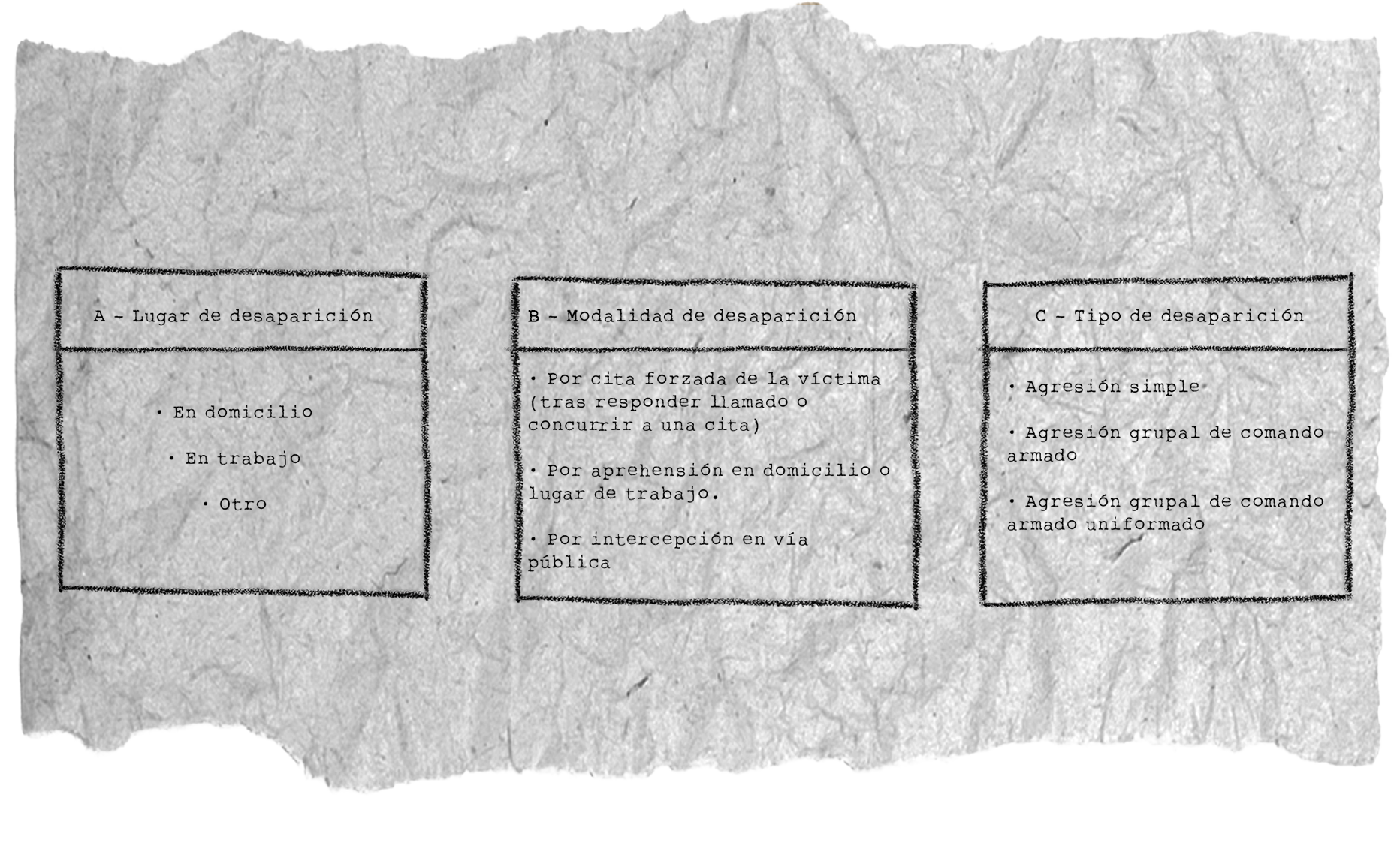
Three journalists are missing to date and 17 have been murdered during this period. However, if we analyze the data collected in each case we will see that 12 were previously missing (for hours, days or months). Of these, three were taken from their homes (Gregorio Jiménez, Moisés Sánchez Cerezo and Anabel Flores) and one at the door of his work (Víctor Manuel Báez Chino, kidnapped at Reporterospoliciacos.com). In the other cases the place of capture is unknown (it can only be affirmed that it did not take place at home or at work) and therefore it is presumed that it occurred on public streets.
In continuing the analysis, we note that during the period studied there were three modalities or forms of disappearance: by summons, apprehension or interception.

1-In some cases, the disappearances were preceded by a telephone call and/or a summons to an appointment. That is to say, sometimes the journalist received a call, went out to run an errand or “voluntarily” attended a “meeting”, but did not return alive. This is the case of Noel López Olguín, who -according to a source- received a phone call on the morning of March 8, 2011, while he was having breakfast at home. After exchanging a couple of words with the caller, he told his wife that he was going to Soteapan to run some errands and would be back in the afternoon, but he never returned.
Sergio Landa Rosado received a call on Sunday, January 20, 2013 while he was working in the editorial office of Diario Cardel, around 4 pm, he left without turning off the computer and telling the two colleagues present “I’ll be right back, don’t turn off the machine, I’m going back to finish what I’m doing”.
Gabriel Huge also told a friend that he was going to a delicate appointment and said, “if I don’t come back in 2 hours, I’ll take care of my daughter”.
In the case of Miguel Morales Estrada -according to a confidential source- precisely the day he disappeared he had been sent by the newspaper’ s director to cover a public safety event, an operation, and from then on he was never heard from again. It is known that Miguel, before disappearing, went to the newspaper to leave his equipment and said he would return, but he never did.
2- Others were not summoned but sought – apprehended – directly at their homes, such as Moisés Sánchez Cerezo and Gregorio Jiménez or in another public place, such as Víctor Manuel Báez Chino. In the case of Gregorio -according to a source- they came to his house, “pointed a gun” at one of his daughters, after which he gave himself up. The assailants were civilians, they were transported in a single van and carried long and short weapons.
3- Some journalists were intercepted, disappeared or executed in a single moment. Thus, in some cases it is only known that they went out to work and nothing else, so it is assumed that at some point they were intercepted. Such is the case of Gabriel Fonseca, who passed by the media outlet where he worked, spoke to his boss, left and never returned. At the newspaper “they were waiting for his Sunday notes”, said a source.
How were the disappearances carried out? Were they simple aggressions (acts of violence carried out by one or two people) or acts executed as a group or as a consequence of an operation?
In 8 of the 13 disappearances analyzed there is no information or details about the circumstances of disappearance. That is to say, it is not known if they voluntarily went to their place of capture, if they were searched or intercepted, and even less, if it was due to simple or group aggression. In the other 5 cases, those who provided information were family members, witnesses, colleagues and authorities.
For example, it was reported that Víctor Manuel Báez Chino was kidnapped by armed men without uniforms on board a gray van at 11:30 p.m. when he and other colleagues were leaving the headquarters of ReporterosPoliciacos.com on Chapultepec Street in Xalapa.
Gregorio Jiménez was arrested in Villa Allende by armed men who showed up at the door of his house, asked for him and before arresting him said “this is the photographer”. They took him by force in a pickup truck. According to what Ricardo Ravelo published in his book Journalistas asesinados: los expedientes, three hooded and armed men got out of Gregorio’s house and took him away in a Honda CRV. The group was a cell of Los Zetas that had him under surveillance; that day there was even a hawk in the vicinity waiting for the journalist to return from taking his daughters to school. They took him away handcuffed from behind.
In the case of Moisés Sánchez Cerezo, a live source interviewed for this investigation remarked that on January 2, 2015 around 7 p.m., an armed commando arrived at the home, as “…we estimate some 9 to 12 people more or less in 5 vehicles”. Everything suggests that it was an operative maneuver, according to the source. He also points out that the commando (apparently from CJNG) acted with the support of state police and municipal transit agents. The neighbors also provided information: they said that the kidnappers were in cars and behind a patrol car. They also said that there were two motorcycle patrol officers stationed nearby, who observed the group of vehicles when they entered to look for the victim and when they fled, but did nothing to prevent the kidnapping.
No public information has been made public about Noel López Olguin. The subject is not addressed in reports, journalistic notes or live sources until the authority in some manifestations indicated that the journalist was apprehended by subjects that came in two vans. Due to the lack of elements we can say that he was not disappeared in an act of group aggression.
Finally, it was reported that Anabel Flores Salazar was apprehended on February 8, 2016, around 2 am, by a group of men in uniform “like military men”, who had long guns, helmets, vests and ski masks. They broke into her home and dragged her away. When the men introduced themselves, they said “we have an arrest warrant” and proceeded to take her away.
In summary: in all the cases in which it is known – or has been made known – how the disappearance took place, it is clear that the method of execution is group or armed commando. Even in one (Anabel’s case), the assailants were wearing uniforms.
Moment 2: Murders
There are 17 journalists murdered in Veracruz between 2010 and 2016. Is there a pattern to these deaths, and are there similarities?
We investigated all the cases. We collected and systematized information on various aspects of the lethal aggression through photos, documents, copies of reports, autopsies or expert reports, as well as details provided in books and interviews. Based on this, we studied each of the modalities of execution (death) and thus reached some conclusions, among them:
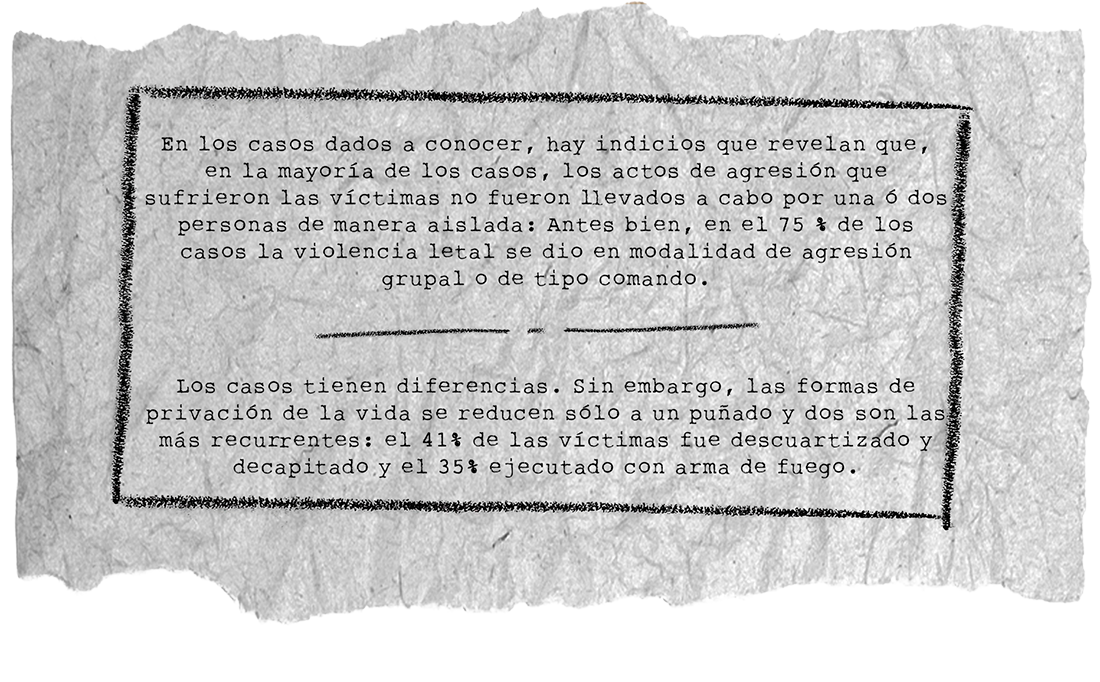
For more details: Two (2) victims were asphyxiated: one was “choked with a toilet jargon”, beaten, with a broken jaw; the second had mechanical asphyxiation and other signs of torture.
Six (6) journalists were hit by firearms. One was shot in the head outside the transit office; another was shot several times (between 8 and 11 bullets, it is not certain how many he was hit) which caused his death a few minutes later. And in a multihomicide scene there were 33 shots over 3 bodies. Two (2) other journalists were shot (4 and 1, respectively) and their bodies also showed signs of torture.
Seven (7) of the 17 victims suffered decapitation and dismemberment. Among them, the bodies of two were subjected to other torments: one was decapitated, mutilated and dismembered, the other was decapitated as a form of death.
Of two other victims it is only known that one received a blow to the head and the second was found run over, with multiple injuries and blindfolded.
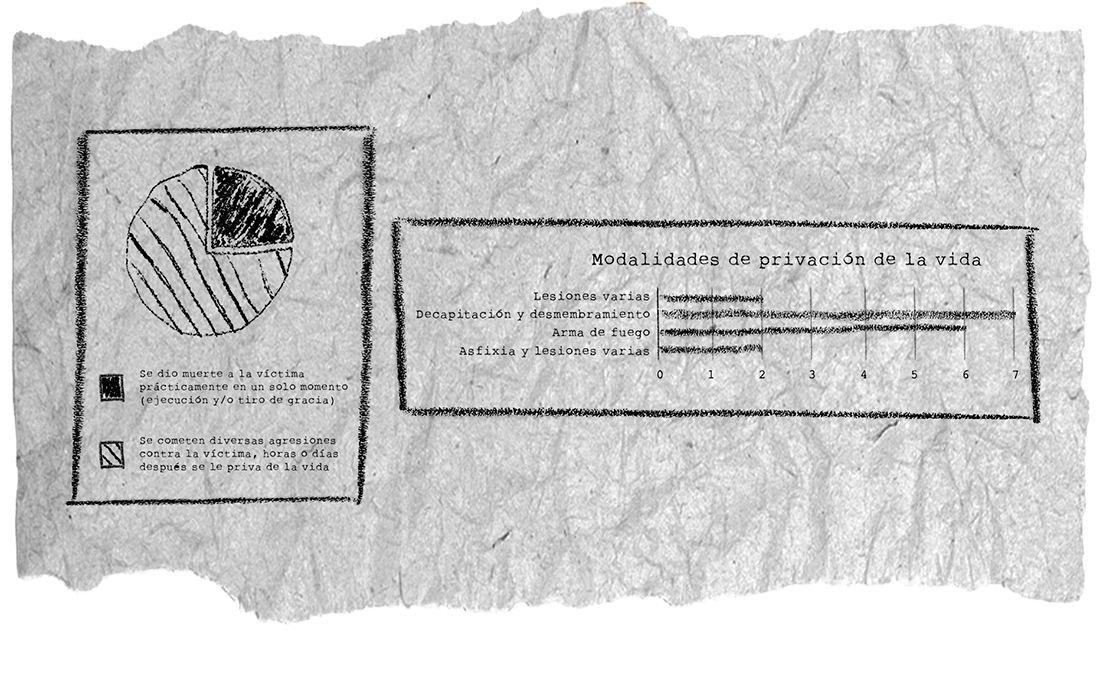
On the other hand, there is another constant: of the 17 homicides, only in 4 cases was death produced practically at a single moment. Manuel Torres González was intercepted and shot in the head. Pedro Tamayo was shot at night, while he was with his wife and two children attending a family stand. Miguel Ángel López Velasco and Misael López Solana, executed in their home, shortly after their assailants entered, but in a context of great pain and psychological violence(3). The rest of the deprivations of life were the result of various injuries and physical aggressions.
When analyzing these last cases and the details of the aggressions that the victims received, another constant was found: before the execution (murder) there is a period of time in which acts of physical and psychological aggression are practiced; in all the cases reported there is evidence of torture.
Moment 3: Finding the bodies and remains of the victims
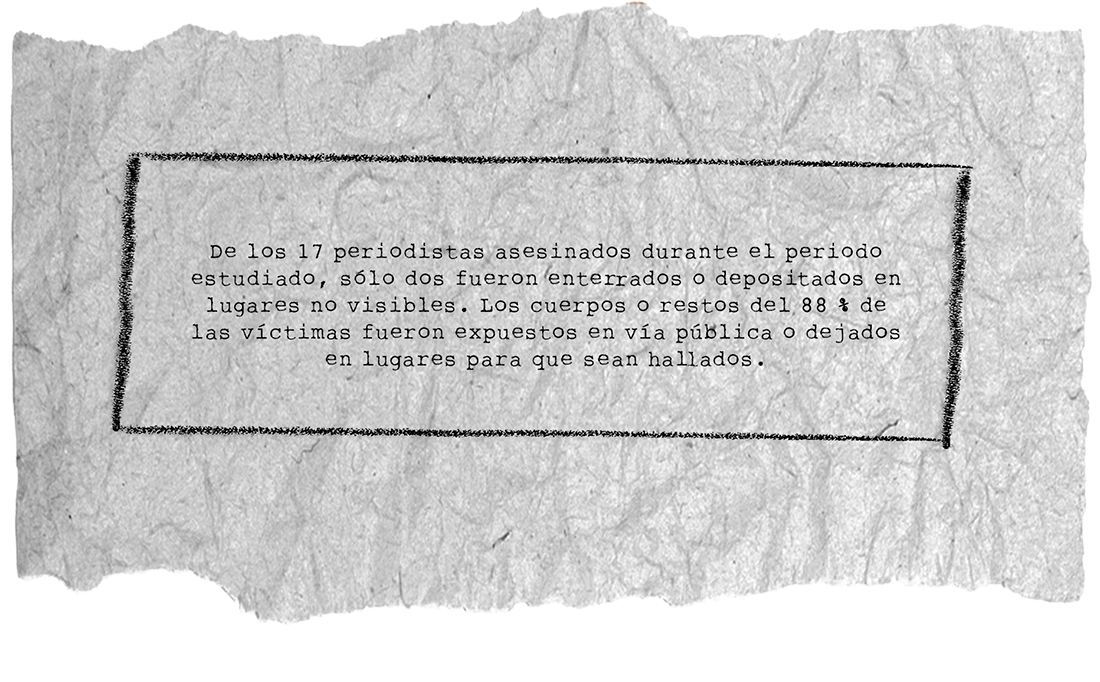
Analyzing the situation, we know that the bodies of 10 people were found on public streets: Yolanda Ordaz, Guillermo Luna Varela, Gabriel Huge, Esteban Rodríguez, Víctor Manuel Báez Chino, Armando Saldaña, Juan Mendoza Delgado, Anabel Flores Salazar, Manuel Torres González and Moisés Sánchez Cerezo.
Four victims were allegedly murdered and found in their homes: Regina Martínez, Miguel Ángel López Velasco, Misael López Solana, Pedro Tamayo (murdered while tending to the food stand they had at the door of the family home). One of the victims (Rubén Espinosa) was executed and found in the home of another person, Nadia Vera, in Mexico City.
The bodies of two other journalists were found in graves in places that were presumably safe houses: Noel López Olguín and Gregorio Jiménez de la Cruz.
In other words, of the 17 journalists murdered during the period studied, only two were buried or deposited in non-visible places. The other 15 were exposed, displayed or left in places with the clear intention of being found.
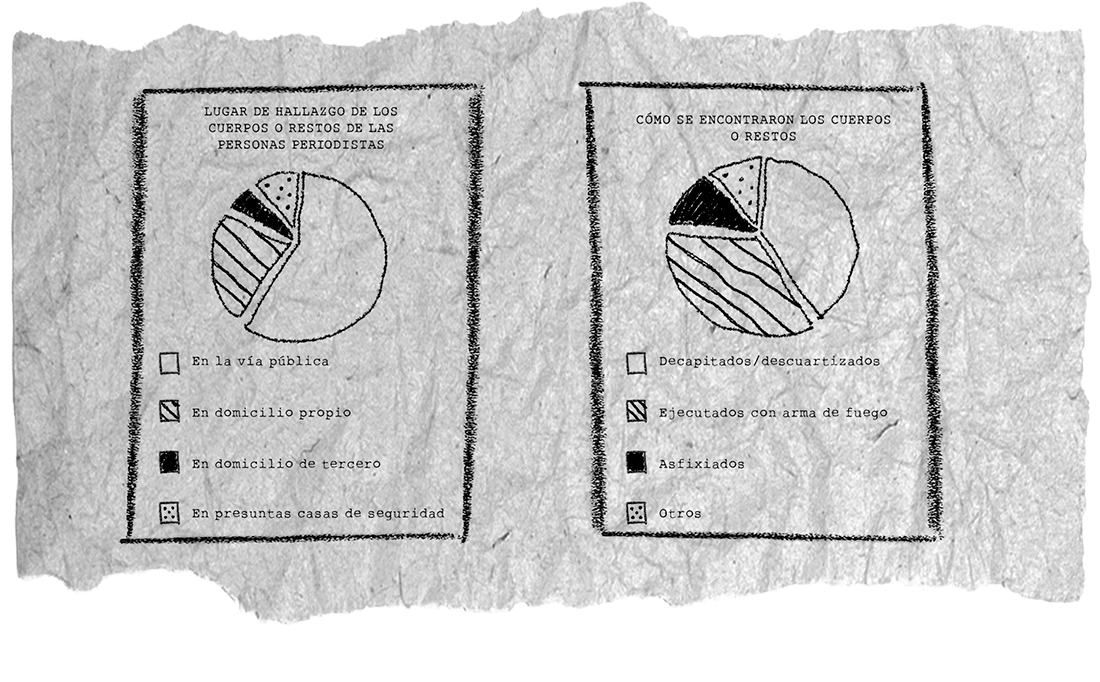
According to the information gathered, the bodies of six victims were found in Veracruz-Boca del Río, while two others were found in Xalapa and the rest in Poza Rica, Tierra Blanca, Benito Juárez, Chinameca, Las Choapas, among other places.
Of the ten bodies found on public roads, four were dismembered and placed in black plastic bags: Guillermo Luna Varela, Gabriel Huge, Esteban Rodríguez and Víctor Manuel Báez Chino. The first three were found in the La Zamorana sewage canal in Boca del Río. In the case of Baez Chino, the body was left a few meters from the Government Palace in Xalapa, which is presumed to be a message. At the same time, next to the bags a sign was placed, presumably signed by Los Zetas, which read: “this happens to those who betray and want to be smart”.
Yolanda Ordaz de la Cruz was also found in Habaneras street, Boca del Rio, where the offices of an important media outlet (Imagen del Golfo) are located. Decapitated, with traces of torture and a sign that read “Friends can also betray. Sincerely: Carranza).
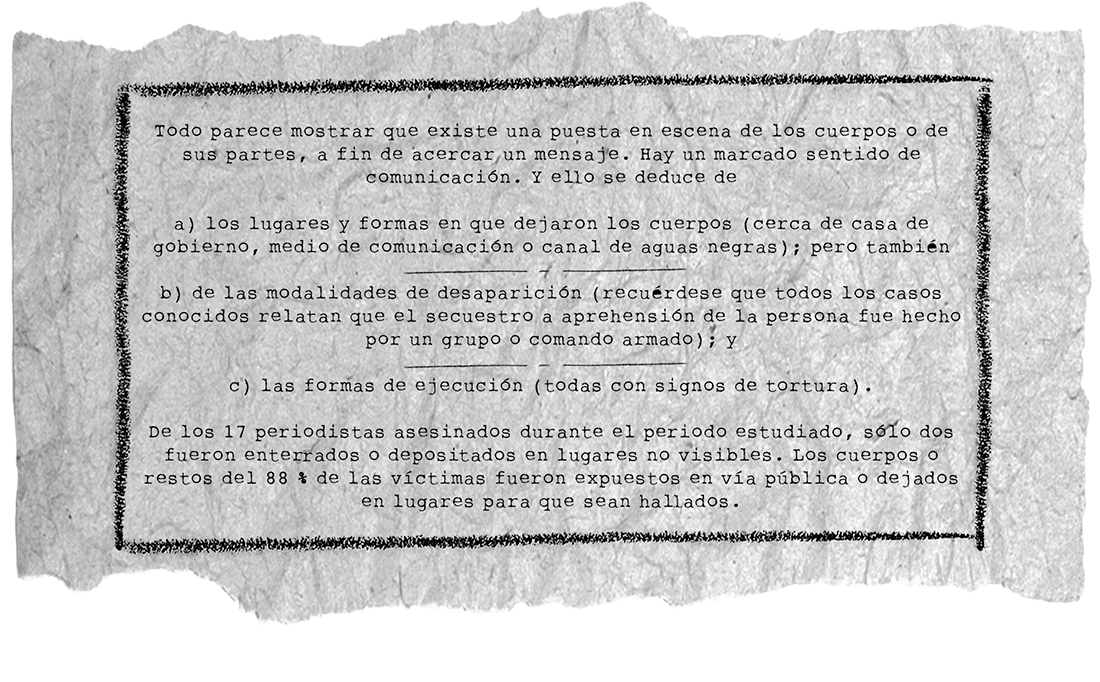
Signs of torture
As we studied the disappearance, execution and discovery of the bodies of the victims, elements and evidence emerged of another phenomenon that is not often mentioned: torture. Analyzing documents, testimonies and all the information available, we can affirm that there are not one, two or three cases of tortured and murdered journalists: in all cases there are indications or elements to presuppose torture.
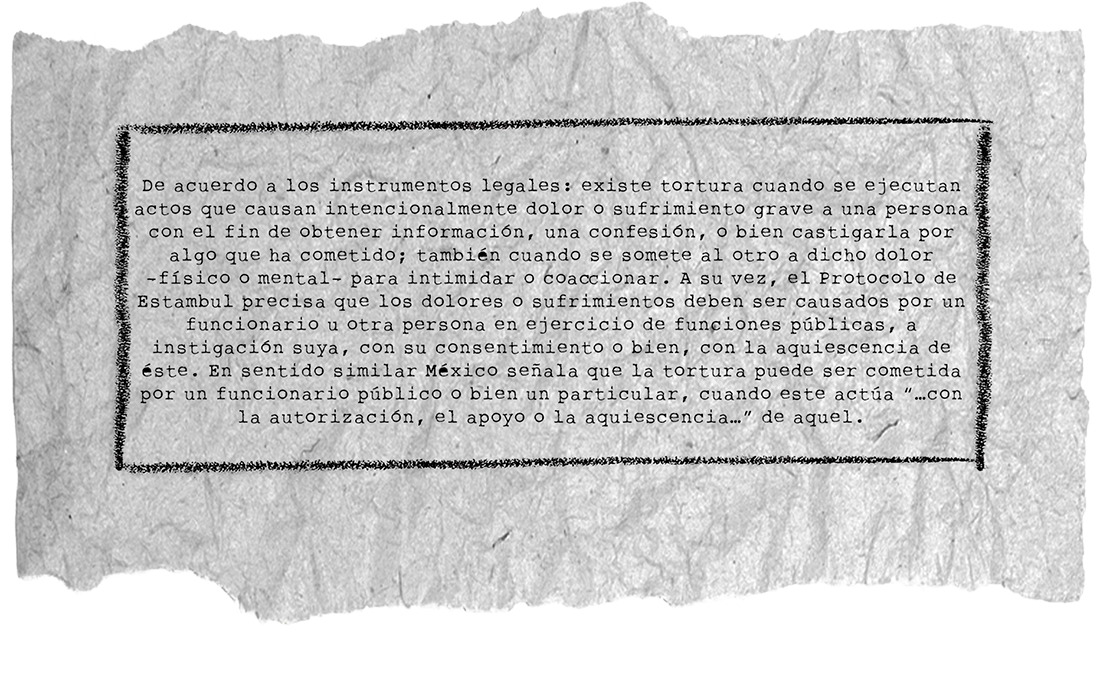
To investigate and prove whether torture occurred, various international and national instruments are used; each one of them provides guidelines to follow the standards set forth in the Protocol and what is known as “minimum standards” must be respected, especially when performing the medical-psychological report. These and other tests are necessary to determine and conclude whether the crime of torture has been committed.
Unfortunately, most of the victims do not have legal assistance or representation in the files, so the information available to family members, widows and colleagues is limited. A few, as well as colleagues or former officials have shared in reports, studies, blogs or press articles certain parts or details of the ministerial investigations. With that, we analyzed each case in order to determine whether or not there was evidence to assess whether or not the person was subjected to torture. That is, if there were signs or signals of pain or suffering inflicted (wounds or bruises on the skin, face, thorax, abdomen, musculoskeletal system, forms of blunt trauma, blows and marks on the feet and hands, injuries due to prolonged positions, sexual torture, among others, and if they could have been executed for the purposes mentioned above.
In the analysis, 4 of the 17 homicide cases in Veracruz 2010 to 2016 are discarded, as the victims were executed immediately after being reached or intercepted by their aggressor or aggressors(7). By virtue of this, the universe to be analyzed is reduced to 13 cases.
In one case it was not possible to have the necessary elements to assess the situation: Noel López Olguín was missing for 3 months; it is known that he died from a blow to the head, but nothing else has been mentioned in the media and other sources. It is not known -or it has not been made public- how long he was with his captors, when he was killed and whether or not his body had injuries, cuts or other signs.
In the remaining 12 cases, the authorities, witnesses, experts and others have provided details on the circumstances, type of injuries, cause of death and method of discovery.
The following is a description of the torture suffered by each of the journalists, but the identity of each one of them has been kept confidential.
Journalist his body was found decapitated. He had bruises, contusions and marks of tied fists (apparently with his hands behind his back). Sources point out that the corpse was in a “chair position”; even colleagues say that before killing her, she was tortured and kept in a cellar.(8)
Journalist was found asphyxiated with the slang of the bathroom; she had several blows and injuries, fracture of the jaw, marks on her face -according to some versions these were caused by a mitten, while the file had as hypothesis that this could be due to a bite.(9) Everything points to that someone sent to interrogate her, to intimidate her. Unlike other cases, in this one there is no dismemberment, no decapitation or mutilation, so it could be a case that “got out of hand”.
Journalists were beaten, skinned (in the face and part of the neck it can be seen that the skin was detached) and decapitated. Their legs and arms were cut off. Their body parts were put in bags and thrown into a sewage canal.(10) The lethal violence against them occurred a week after Regina’s case. There are indications that they were tortured. They were on the “black” list (death threats) referred to by colleagues.
Thejournalist had friction burns on his neck, so it is presumed that he was first hanged, then decapitated and mutilated. The expert indicates that the body presented several injuries in the body by sharp weapons and dismemberment of lower extremities and an upper one. “The wounds were puncture wounds, blunt and short blunt, which are produced with sharp instruments, with force and greater force such as machetes or guillotine. He died a slow death of mechanical origin, related to the blunt force injuries»(11).
Journalist was found in a supposed safe house, along with other victims of a presumed group of hired killers. The alleged perpetrators testified before the authorities and indicated that the victim was held during the day of his capture, and it was until 3:00 a.m. the following day that they put the pre-established plan into action: they mutilated him (cut off his head) and thus caused his death. After that, they stripped him naked, took pictures of him and then buried him in the aforementioned property.(12)
Journalist was missing for 18 days; his body was found decapitated and dismembered apparently post mortem. The confessed assailant is a former policeman named Clemente Noé Rodríguez; he claims that the victim’s throat was slit the same night of the abduction.
According to some sources, thejournalist had signs of torture and four bullet wounds to the back of his head. The Freedom House report indicates that he had marks of sharp objects and broken bones.(4)
Journalist was missing for 24 hours; he was found on the road, half naked, beaten all over his body, blindfolded. He supposedly died as a result of being run over. Later, in the photos that appear in the investigation-file, the body no longer has the blindfold on his eyes/head.(15)
Thejournalist was found tied by the extremities; he presented multiple puncture wounds, exorations, ecchymosis. The cause of death according to an expert was due to “a firearm projectile”. It is referred that “… he was tied to the upper and lower extremities with a certain gray adhesive tape…” and that, “…although he did not present all the injuries and typical signs of a mechanical asphyxia, it is noticed that some maneuvers of this nature were performed, since the handles of a bag were placed on his neck…”(16) The file and the contextual analysis provide more details.(17)
Thejournalist was half naked, handcuffed and with traces of injuries, thorax restrained by blows. Her head was covered by a plastic bag. She died from mechanical asphyxia and thorax contusions.(15)
In summary, in all the cases for which data are available (or have been made public), it has been possible to appreciate that the victims show signs of torture.
If we look at the general figures of victims who were not executed immediately after having contact with their aggressor/s, we can say that 92% have signs of torture. That is to say, 17 journalists were murdered; of these, 4 were executed after contact with the aggressor. This left the universe of analysis of indications of torture on 13 journalists. Of these 13, only in one case the necessary data are not known or have not been made known, while in the other 12 there are elements of evidence of torture.
At the same time, many of them had work material taken from them (notebooks with notes, laptops, cameras, tape recorders and others). This is not a minor detail. This is important for several reasons, mainly because: a) it communicates an intention to silence and erase the work that the journalist was doing; b) it expresses the intention to obtain information from the victim, either through his or her person -by intimidation and/or torture- or through what is contained in his or her work instruments.
This project sought to document whether during the acts of violence (deprivation of liberty, torture and/or execution) or afterwards, the victims were deprived of their work tools. We were able to learn that: Moisés Sánchez Cerezo’s alleged assailants took his camera, cell phone, tablet and computer.(16) It should not be forgotten that this victim was kidnapped by a commando of 9 people and 5 vehicles (apparently CJNG) with the support of state police and municipal transit agents.
In the case of Regina Martínez there are different versions: according to some sources they stole her computer and two cassettes with interviews, as well as cellular phones.(18)
Noel López Olguín’s camera was stolen, but it was found three months later in possession of the alleged aggressor, at the time of his arrest (a situation presented by the authorities as fortuitous).(19)
Computers and notebooks disappeared from Víctor Manuel Báez Chino. This case is different. Fuente viva indicates that the material was taken by some colleagues of Reporteros policíacos, who had a key to the victim’s home; and they could have sought to guard the material for their own security (of the media, of the project, of the sources, of other colleagues or even of the victims’ relatives).
In the case of Miguel Ángel López Velasco, the authorities said that the motive for the crime was robbery, but that they only took a computer that was never found.
Finally, Rubén Espinosa’s phone also disappeared from the crime scene, and there is geolocation data after the time of his death, which locates him far from the place where he was killed.
The situation of insecurity in which journalists worked was so marked that, on occasions, before going out to report or before attending a meeting or a forced meeting with members of organized crime, journalists commented on the situation with colleagues or family members – in case they did not return – and/or left their work material in safekeeping. This was documented in the case of Miguel Morales Estrada: reportedly, the last day he was seen alive he went out to cover a story but first went to the newspaper and left his camera.(20)
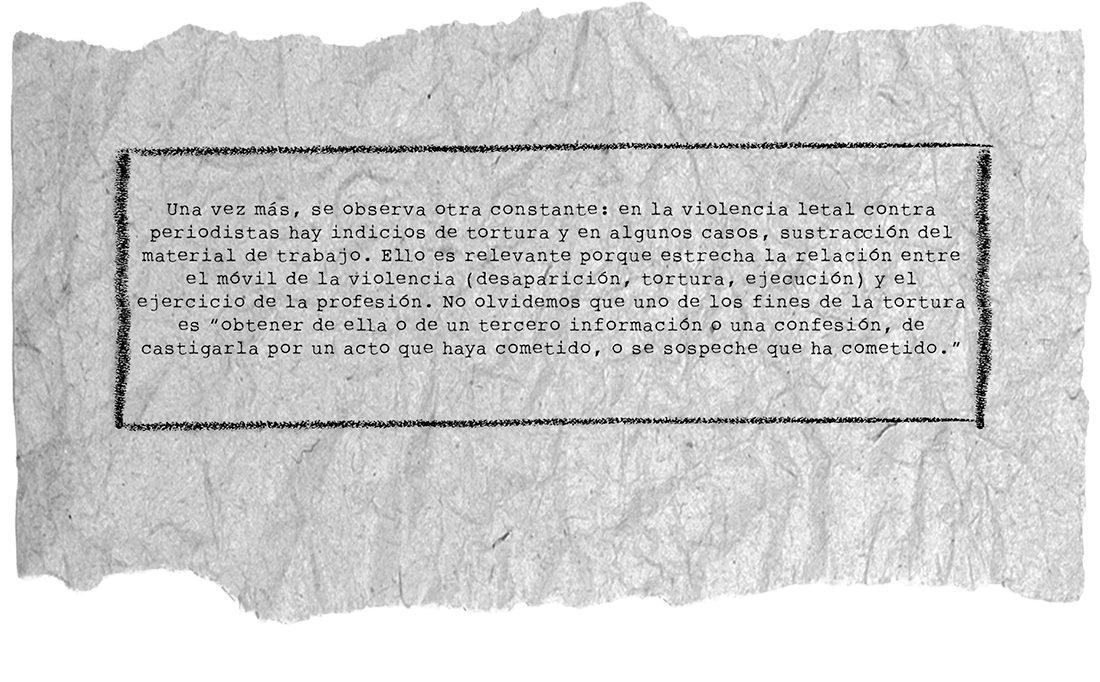
Allegedly liable
Taking into account what has been officially made public, it was possible to count that in 15 of the 20 cases the prosecutor’s office has identified, charged or detained the alleged perpetrators.
In view of this, it is worth asking how many of these people who have been charged or detained belong to organized crime groups? Which group do they belong to? How many are or were public security officials or agents? How many perpetrators worked for private interests or were even hired assassins? These questions are key to trying to understand -in part- the exercise of lethal violence.
According to what has been recorded, at least 29 people have been investigated, charged and some detained at some point by the prosecutor’s office regarding the cases of murdered and disappeared journalists between 2010 and 2016.
From that universe of people, according to the analysis here practiced, it emerges that about 25% belonged or had belonged to a public security institution or municipal agency.
It was also possible to count that according to what was expressed by the Prosecutor’s Office and by virtue of the content of the confessions, about 75% of the persons indicated by the Prosecutor’s Office and/or detained were alleged members of organized crime. Of these, the majority belonged to Los Zetas, some to CJNG, and of the rest, the specific cartel is not indicated.
However, based on all the information gathered and cross-checked, we found that in the 20 cases there are more than 60 people identified by the executive or ministerial authorities as possibly responsible for the disappearances and/or homicides. Not all of them have been investigated in the respective files, either because they could not be identified since they had been indicated with nicknames or physical signs, they were not summoned to testify by the authorities, or they were summoned but not investigated. The latter can be seen in the case of Pedro Tamayo; at the time eleven state police officers were summoned to testify for their alleged participation in the death of the communicator, but later no ministerial charges were brought against those or other officials.(21)
On the other hand, when analyzing the situation of the first 21 people that the prosecutor’s office pointed out as responsible and consequently arrested, it was noticed that more than half of them confessed “voluntarily and spontaneously” as it is usually said in the ministerial jargon. Of these, 3 have retracted their confessions. For example: Jorge Antonio Hernández Silva(22) (Regina Martínez case) said that his confession was taken under torture by elements of the Veracruz Investigation Agency. Clemente Noé Rodríguez Martínez (Moisés Sánchez case) and Daniel Pacheco Gutiérrez (Rubén Espinosa case) also retracted their confessions and argued that they were tortured.
Hypothesis
The hypotheses that have been put forward to explain each disappearance and homicide were analyzed. To do this, we first proceeded to compile all the hypotheses put forward in reports, journalistic analysis texts, press releases and press conferences by the authorities, notes, extracts from files and, above all, what was said by relatives and colleagues of the victims (i.e., more than 350 documentary sources and more than 30 interviews with live sources). Based on this, a special matrix was generated to cross-reference the data and thus study, firstly, who was held responsible and, secondly, what motives could have provoked the lethal violence.
When analyzing the universe of sources, we saw that about 60 generate more specific indications. Of these, we counted how many sources point out alleged perpetrators and who they are: it emerged that the most pointed out actor was organized crime (23 sources); this data preceded the investigation, that is, since the context analysis was undertaken, it was known that the collective narrative usually points out that cartels subject journalists to the “silver or lead” law.(23)
The compilation and analysis work allowed us to sustain that in reports, journalistic analysis texts, press releases and press conferences of the authorities, notes and excerpts from files, experts, officials, colleagues and relatives of the victims also pointed to other actors as responsible for the lethal violence. Thus, organized crime is followed by three other actors: public officials or political figures (8 sources), members of public security such as municipal police (6 sources), and individuals or legal entities from the private sector (6 sources).
In other words, the phenomenon of lethal violence against the press is not explained by the actions of the cartels, their struggles and reactions. This is a determining factor. If we look at the numbers, the sum of the other actors (all presumably from the sphere of legality) is almost equivalent to the role and percentage of representation that the illegal groups have. In addition, according to the research carried out, we can affirm that:
** 18 of the 20 cases have 3 to 7 hypotheses that attempt to explain why lethal violence occurred.
** The lethal violence analyzed is explained by the triangle of action typical of macro phenomena, where public, private and organized crime actors interact.
** Almost all the motives point to issues, activities or risks inherent to the journalistic exercise. More details on this can be found in the “context” section.
II- Extract on the conclusions and findings of the macro-criminal investigation
1-65% of the journalists are presumed missing on public roads. 23% of the victims were searched for and taken by their captors directly from their homes. 2% were taken from the door of the media outlet.
2-75% of the murdered or disappeared journalists had received recent threats.
3-In all the cases reported(24), the disappearance was due to a group or commando type aggression, and in one of them, the aggressors were uniformed individuals.
4 – 88% of the bodies of the victims were exposed on public roads or left in visible places. In other words, of the 17 journalists murdered, only two were buried or deposited in non-visible places (mass graves, in safe houses).
5-The majority of the murdered persons (65%) were previously disappeared and then, hours or days later, murdered. Some victims were killed practically at the same moment they had contact with their assailants.
6-In all the cases reported, there is evidence of torture.
7- It is significant the work material that the assailants stole or was not found at the crime scene: cameras, notebooks, cell phones, tablets, cell phones, among others.
8-Although the methods of execution (deprivation of life) are diverse, two are the most recurrent: 41% were dismembered and decapitated and 35% executed with a firearm.
9-There is a marked staging of the bodies or their parts; behind it, there is usually a message. This is perceived in the majority sense of allowing or looking for the bodies to be found; also in the form of execution and finding of the murdered persons, and above all, in those that were even left together with a specific poster or sign.
10-The five cities with the highest concentration of lethal violence against the press are Boca del Río, Xalapa, Poza Rica, Tierra Blanca and Veracruz.
On the other hand, the analysis of the investigations and the judicial individualization of those responsible(25) for such lethal violence, indicates that:
11-In 15 of the 20 disappearances/homicides the system judicially individualized one or more perpetrators of such lethal violence. In other words, in most of the cases the perpetrators were investigated, arrested and/or charged. The great majority of these are presumed direct perpetrators (hired killers or material aggressors).
12-In a third of the total cases, the alleged perpetrators confessed “voluntarily and spontaneously” to their participation. If we analyze the first 21 detainees or accused, half of them confessed.
13-In 18 of the 20 cases of disappearance and homicide there are between 3 to 7 hypotheses about the motives and perpetrators of such violence.
14-The official hypothesis usually has the same nuance: the aggressors were members of organized crime.
15-Of the universe of persons detained or indicated as allegedly responsible by the Public Prosecutor’s Office, it is known that about 25% belonged or had belonged to a public security institution or municipal president. Analyzing also the content of the communiqués of the Prosecutor’s Office and the confessions of the detainees, it was possible to count that about 75% of the persons identified and/or detained were alleged members of organized crime -according to the Prosecutor’s Office or the confessed persons themselves-. Of these, the majority allegedly belonged to Los Zetas, others to the CJNG, and the rest did not have a specific cartel.
Notes, quotes.
(1)UNESCO. Observatory of Killed Journalists. Available at: https://www.unesco.org/en/safety-journalists/observatory/statistics
(2)Article 19. “Journalism at Risk”. Available at: https://articulo19.org/
(3) The psychological pain of knowing and hearing that your loved one is being murdered in the next room should not be ignored. But as detailed in open sources and according to the account of a live source, the victims died without other physical aggressions “they did not suffer like other tortures… they were seconds, minutes, not hours” interview with the victim’s relative.
(4)See https://www.argentina.gob. ar – “The term ‘torture’ means any act by which severe pain or suffering, whether physical or mental, is intentionally inflicted on a person for such purposes as obtaining from him or a third person information or a confession, punishing him for an act he or a third person has committed or is suspected of having committed, or intimidating or coercing him or a third person to commit, or intimidating or coercing him or a third person to commit an act which he or a third person has committed or is suspected of having committed, or to intimidate or coerce him or others, or for any reason based on discrimination of any kind, when such pain or suffering is inflicted by or at the instigation of or with the consent or acquiescence of a public official or other person acting in an official capacity. Pain or suffering arising only from, inherent in or incidental to lawful sanctions shall not be considered torture” (United Nations Convention against Torture and Other Cruel, Inhuman or Degrading Treatment or Punishment, 1984).
(5) https://www.diputados.gob.mx GENERAL LAW TO PREVENT, INVESTIGATE AND PUNISH TORTURE AND OTHER CRUEL, INHUMAN OR DEGRADING TREATMENT OR PUNISHMENT.
(6) In this sense, see https://www.cndh.org.mx
(7) Manuel Torres Gonzalez was killed with a “bullet” to the head as he left the transit office and Pedro Tamayo was shot several times in the door of his house. In the case of Miguel Angel and Misael, they died in the family home, in very painful circumstances for both of them. By virtue of how the bodies were found and according to a live source, the victims heard and/or witnessed the death of their other loved ones. However, the source clarifies “… we should feel fortunate to know that they did not suffer like other tortures, like Huge, like Yolanda, I should feel fortunate to know that they were seconds, minutes, not hours” interview with Yasmin Velasco.
(8)
Live source (interview)
(9) As reported in the case file, as well as https://impunidad.ipys.org and Fuente viva (interview).
(10)https://www.blog.expediente.mx/nota/
(11)As reported in the case file, as well as https://mataranadie.com/victor-manuel-baez-chino/ and a live source (interview).
(12)https://www.presencia.mx/nota.aspx?id=194647&s=3; book “Asesinatos de reporteros: los expedientes” Ricardo Ravelo y Fuente viva (interview)
(13)https://mataranadie.com/jose-moises-sanchez-cerezo/ https://www.lanacion.com.ar/el-mundo/aparece-muerto-un-periodista-en-mexico-nid1763387/ and the Freedom House 2015 Report.
(14)https://www.alcalorpolitico.com/
(15)https://mataranadie.com/anabel-flores-salazar and https://www.lapoliticaonline.com/mexico/en-foco-mx/n-88477-period ista-veracruzana-asesinada/
(16)https://impunidad.ipys.org/pages/
(17)Context Analysis of the case and https://actualidad.rt.com/actualidad/182003-periodista-espinosa-mexico-matado-tortura-rostro
(18)https://letraslibres.com/politica/los-anos-que-le-robaron-al-periodismo/
(19)http://www.nuestraaparenterendicion.com/
(20)According to Reporters Without Borders https://rsf.org/es/un-periodista-se-encuentra-desaparecido-en-veracruz-desde-hace-una-semana
(21)La Jornada. “Comparecen 11 policías estatales por el asesinato de Pedro Tamayo” 23/07/2016. Available at: Presencia. “Veracruz, ruta sangrienta de periodistas en los gobiernos de Duarte y Yunes”. 15/10/2017. (22)Available at: https://www.presencia.mx/
(22) “Jorge Antonio Hernández, alias ‘El Silva’, who was sentenced to 38 years in prison. But months later, on August 8, 2013, the sentence was overturned: the Superior Court of Justice of the State of Veracruz annulled it, pointing out that the evidence against El Silva was insufficient and consisted basically of the defendant’s confession, allegedly obtained under torture.” Reportero sin fronteras. Available at:https://www.rsf-es.org/wp-content page 19.
(23)It is an expression widely used to point out from the realm of the illegal to another who either accepts the bribe/money, or will be killed. It was a form of negotiation used by Pablo Escobar, who used to send notes with this phrase to politicians, military or police officers, referring with these words that he had two options: to be included in their “payroll” or to die shot by a hitman.
(24) Conclusions and inferences were made based on all the information gathered from open sources (reports, documents, journalistic notes, press releases and public expressions of authority), data from files and live sources (interviews with family members and colleagues). More than 350 open sources and 30 live sources were consulted. In some cases, it was found that certain data or elements have not been disclosed or are not known by the sources.
(25) Details of these figures and other data can be found in section 5.4.